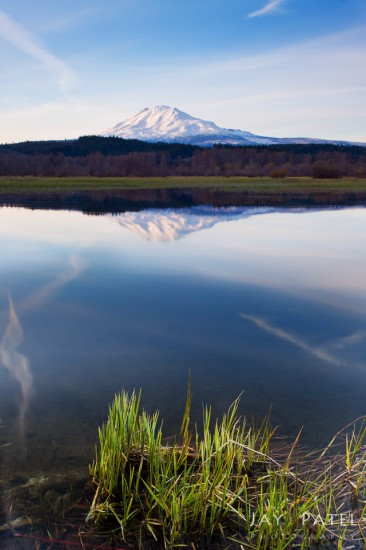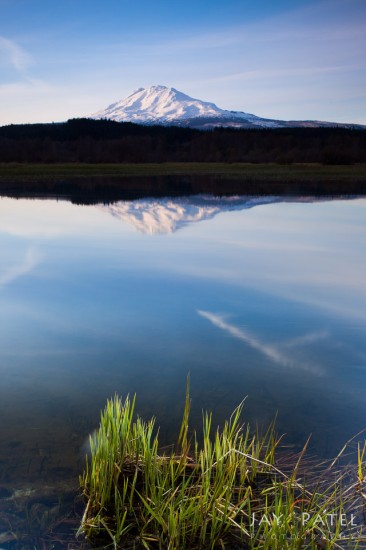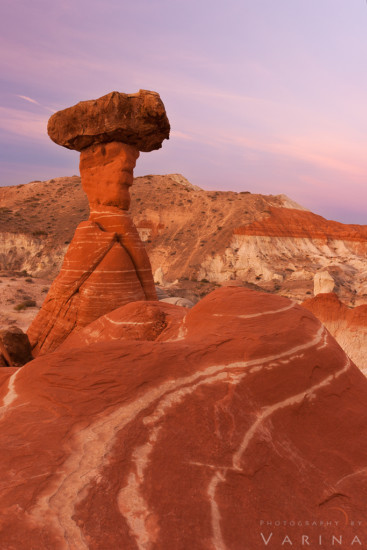Graduated Neutral Density Filters (GND) are designed to reduce the dynamic range of the landscape photo you are trying to capture and allow you capture an high dynamic range photo with a single shot. So it is perfectly natural for us to get this question:
Should I carry Graduated Neutral Density Filters or just rely high dynamic range (HDR) processing in Photoshop?
Our answer is always the same… it depends“. The important thing is to understand the advantages of each option and to know when to use one or the other… or both. If you know how to use a GND filters, you can produce the results with a graduated neutral density filters that are very similar to a manually-blended image.
Take a look at the landscape photos of Mt. Adam captured in Mount Adams Wilderness in Washington. In the first image, I used our manual Blending with Light Photoshop workflow to blend two bracketed images using Photoshop layers and masks. The goal when blending images is to preserve the natural shadows and all the detail in the highlights. In the end, we want to create an image that is as close as possible to our memory of the reality of the scene.
The second photos was taken in exactly the same spot – just a few minutes earlier. For this shot, Jay used a 3-stop GND filter. The filter successfully brought down the highlights in the sky so that the camera could capture the entire dynamic range in just one shot. You may notice that the trees at the base of the mountain are much darker in this image. That’s a result of the use of the GND filter.
In this case, the GND filter worked well to reduce the brightness at the top of the image, but it also darkened the trees more than we’d like. For this particular image, the manually-blended landscape photo is just a bit closer to the reality of the scene that evening. So does it mean that it is better than then one created using the GND photography filter? Not necessarily. For this particular image, the dead vegetation at the horizon was not appealing enough to call it a better image.
As you can see from the Mt. Adams example, we can easily replace a GND filter with a manually-blended landscape photo. So, why should one bother to purchase a GND filter? In the Mt. Adam’s photo above, it was not my intention to darken the vegetation in the mid-ground.
When to use Graduated Neutral Density Filter
However, there are times when I would intentionally choose to darken part of the landscape photo using a GND filter. This may be because the details in that part of the image do not make the image more appealing or I want to include a silhouette in my image.

Silhouette effect in landscape photography created using a Graduated Neutral Density Filter, Canon Beach, Oregon
In the landscape photo from Oregon, I used a GND filter to satisfy both these criteria to come away with a stunning shot from Canon Beach. In this case, having a GND filter allowed me to get it right in-camera and simplified my post-processing workflow.
When NOT to use Graduated Neutral Density Filter
Take a look at this shot by Varina of the Toadstool hoodoo from Grand Staircase-Escalante National Monument in Utah. The light was really nice – the sky was changing color a few minutes before sunrise, and very soft morning light kissed the orange rocks in front of me. The sun was getting ready to rise over her left shoulder – and the scene was pretty evenly lit, since Varina wasn’t shooting into the sun. The problem was that it was not possible to capture the entire dynamic range in a single frame without a Graduated Neutral Density filter… and Varina didn’t want to use one.
Why not? Well, as you can see, the horizon in this shot is not straight. GND filters are perfect when the horizon is relatively straight. We use them for sunset or sunrise shots – where the sky is bright and the ground is dark. The filter can slide up or down to allow the photographer to adjust for the position of the horizon. They are incredibly useful little buggers if you enjoy landscape photography.
Unfortunately, in this photograph, the line between sky and ground isn’t straight. A GND filter would have made a dark line across the top of the hoodoo. No good. So Varina had to use exposure bracketing instead. She took two photographs from the same spot – using a remote release to make sure the camera didn’t move at all between exposures. The first shot was exposed correctly for the sky – so the sky looked great, but the ground was too dark. The second shot was exposed correctly for the ground – which meant the sky was too bright.
Varina then used Photoshop layers and masks to combine these two camera exposure and create a final landscape photo that represents the scene as I remember it.
There are times when we prefer to use a graduated neutral density filter over a manually blended landscape photo. Here is a short video where Jay explain why we carry a GND filter.
In the end, it’s all about understanding the options that are available. Take the time to experiment with GND filters and HDR processing. Find out what works best in any given situation. Most importantly, make the effort to understand WHY that approach is best. Each option has it’s place. We teach our students how to use GND filters during our on-the-ground workshops… and we teach manual blending techniques in video courses.
Visual Wilderness https://ift.tt/2NYmYHd
Sourced by Time Trap Photography sharing the best photography tips, news and tricks throughout the industry. Time Trap Photography is dedicated to freezing those special moments in life that can be revisited and admired for generations to come. - Shannon Bourque
Please visit our main site for booking availability and rates.

Receive valuable industry knowledge delivered free to your email each day.










No comments:
Post a Comment
Thank you so much for your comment. A moderator will review and approve all relevant posts. We appreciate your support and encourage you to stay with us by subscribing to our email updates. Where you can easily pick and choose what photography subjects interests you. Subscription link: http://bit.ly/photo-sub